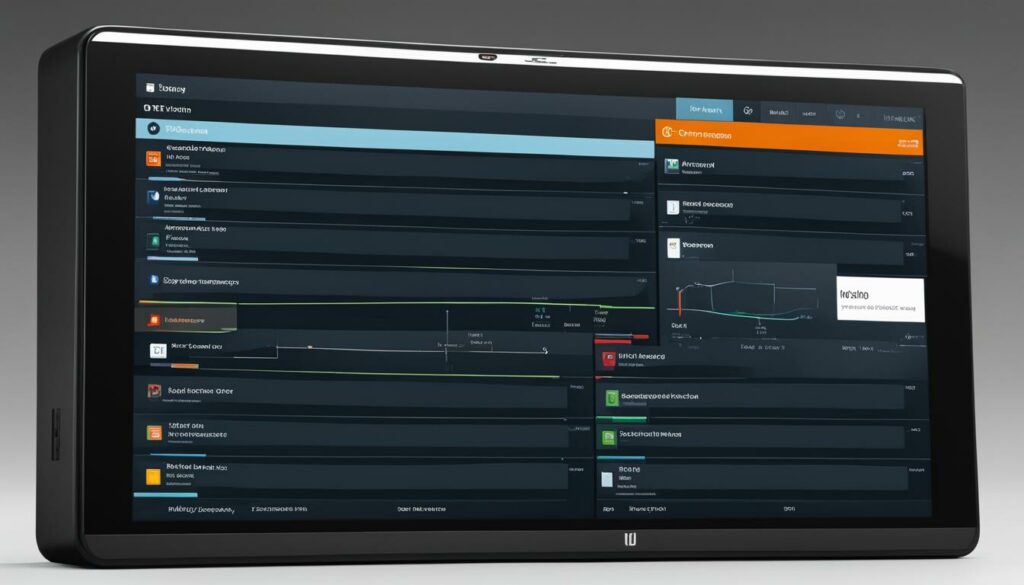A Content Management System (CMS) is a software application that allows you to create, manage, and publish digital content. Whether you have a personal blog, a small business website, or a large enterprise platform, a CMS is essential for efficient web content management.
With a CMS, you have a centralized platform to streamline your content creation process. It provides tools and features to organize, edit, and publish your content across multiple channels. From website CMS to content management software, online content management to open source CMS, there are various solutions available to meet your specific needs.
Key Takeaways:
- A Content Management System (CMS) is a software application that simplifies content creation and management.
- Using a CMS improves collaboration between teams, streamlines content publishing, and optimizes content for search engines.
- There are popular CMS options like WordPress, Drupal, Joomla, Magento, and Shopify with different features and functionalities.
- The content management process involves content creation, organization, distribution, and maintenance.
- Streamlining the content management process increases productivity, ensures content consistency, and enhances user experiences.
Ready to streamline your web content? Sign up for WordPress Hosting from BoostedHost for optimal performance.
Why is a CMS important?
A Content Management System (CMS) plays a crucial role in the success of businesses by streamlining the content creation and management process. With a CMS, you can create, edit, and publish content quickly and efficiently, saving valuable time and resources. Let’s explore the key benefits of using a CMS and understand why it is important for your business.
Saving Time and Resources
One of the primary advantages of a CMS is its ability to streamline content creation. With a user-friendly interface and intuitive editing tools, you can easily create and publish content without any technical expertise. The CMS eliminates the need for manual coding, allowing you to focus on generating engaging content that resonates with your audience. By automating repetitive tasks, a CMS frees up your time and resources, enabling you to concentrate on other essential aspects of your business.
Improved Collaboration and Communication
A CMS provides a centralized platform for teams to collaborate effectively. With features like user management and workflow management, you can assign roles and permissions to different team members, ensuring smooth collaboration and streamlined content approval processes. The CMS also facilitates clear communication by providing a platform for discussions, comments, and feedback, fostering a collaborative environment where everyone can contribute and refine content.
Enhanced SEO and Tracking Capabilities
When it comes to optimizing your content for search engines, a CMS can be your best ally. It offers built-in SEO features such as customizable meta tags, URLs, and sitemaps, helping you enhance your website’s visibility and rank higher in search engine results. Additionally, a CMS allows you to track important metrics such as website traffic, engagement, and conversion rates. This valuable data can guide your content strategy, enabling you to make data-driven decisions and continuously improve your website’s performance.
“A CMS is like a Swiss army knife for content creation and management. It empowers businesses to create, collaborate, and optimize their digital content effectively.”
– Jane Smith, Digital Marketing Expert
BoostedHost WordPress Hosting:
Optimize Your CMS Performance
When it comes to choosing the right CMS hosting, BoostedHost WordPress Hosting is the optimal choice. With reliable servers, advanced security features, and unmatched performance, BoostedHost ensures that your CMS operates seamlessly and delivers a superior user experience. Sign up for BoostedHost WordPress Hosting through this link and experience the power of a high-performing CMS.
In Summary
A CMS is not just a tool; it is a vital component of your content strategy. Its ability to streamline content creation, improve collaboration, optimize for search engines, and track metrics makes it indispensable for businesses. By leveraging the power of a CMS, you can save time and resources, enhance productivity, and deliver compelling content that engages and captivates your target audience.
How does a CMS work?
A content management system (CMS) consists of two main components: the content management application and the content delivery application. These components work together to streamline the process of creating, managing, and delivering digital content for websites and other channels.
The content management application serves as the backend of the CMS, providing a user-friendly interface for content creators and administrators. It allows you to create, edit, and manage content efficiently. This application typically includes various features and tools such as:
- Content creation tools: These tools enable you to create and format content easily, without the need for coding or technical expertise.
- Media libraries: You can upload, organize, and manage media files like images and videos within the CMS.
- Workflow management: This feature allows you to set up approval processes, assign tasks to collaborators, and track the progress of content creation.
- User management: You can control user access and permissions within the CMS, ensuring that only authorized individuals can edit or publish content.
- Analytics: The CMS provides data and insights into how your content is performing, including metrics such as page views, engagement, and conversions.
The content delivery application serves as the frontend of the CMS, where visitors can view and interact with the published content. It displays the content on your website or other channels, ensuring a seamless user experience. It’s responsible for rendering the content in a visually appealing and optimized manner, regardless of the device or browser used.
With the CMS components working together, you can create and manage content in the content management application, and the content delivery application handles the presentation and distribution of that content to your audience.
Benefits of a CMS
A CMS simplifies content management, allowing you to focus on creating high-quality, engaging content. It provides a centralized platform for content creation, organization, and delivery, leading to:
- Increased efficiency: The CMS streamlines the content creation and management process, making it easier and faster to publish new content and update existing content.
- Better collaboration: With features like workflow management and user management, teams can collaborate effectively, assign tasks, and track progress.
- Optimized content: The content management application offers tools for optimizing content for search engines, improving your website’s visibility and ranking in search results.
- Improved user experience: The content delivery application ensures that your content is displayed consistently across different devices and browsers, providing a seamless experience for your visitors.
Overall, a CMS empowers you to create and manage compelling content while delivering it efficiently to your audience. It simplifies the process and enhances the effectiveness of your content strategy.
Comparison of CMS Components
| CMS Component | Content Management Application | Content Delivery Application |
|---|---|---|
| Function | Backend tool for content creation, organization, and management | Frontend tool for displaying and delivering published content |
| Features |
|
N/A |
| Responsibilities |
|
|
Benefits of using a CMS
Using a Content Management System (CMS) has numerous benefits for businesses. Let’s explore how a CMS can revolutionize your content creation and management process.
1. Centralized Platform for Content Creation and Management
A CMS provides a centralized platform for all your content needs. It allows you to easily create, edit, and manage content from one location. No more hunting through multiple folders or platforms. With a CMS, you can stay organized and have all your content readily accessible.
2. Streamlined Content Publishing Process
Gone are the days of manually uploading and formatting content. A CMS streamlines the publishing process by providing intuitive tools that simplify content creation and distribution. You can easily schedule posts, apply templates, and publish across multiple channels with just a few clicks.
3. Enhanced Collaboration Between Teams
A CMS promotes seamless collaboration between teams by providing a user-friendly interface. Even non-technical users can contribute, edit, and manage content without any coding knowledge. With features like content approval workflows, everyone can work together efficiently, ensuring a smooth content creation process.
4. User-Friendly Interface
With a CMS, you don’t need to be a web expert to manage your content. The user-friendly interface makes it easy to navigate and update your website. You can effortlessly add images, videos, and other media elements with a simple drag-and-drop function.
5. Improved SEO with Optimized Content
A CMS can improve your website’s visibility on search engines. It provides built-in SEO features that help optimize your content, URLs, meta tags, and more. By following best practices and utilizing SEO tools within the CMS, you can boost your website’s ranking and attract more organic traffic.
6. Tracking Metrics for Performance Measurement
With a CMS, you can track important metrics to measure the effectiveness of your content strategy. Analytical tools provide insights into your website’s traffic, engagement, conversions, and more. These valuable metrics allow you to make data-driven decisions, refine your content, and achieve better results.

In summary, a CMS offers a centralized platform, streamlines content publishing, enhances collaboration, provides a user-friendly interface, improves SEO, and allows tracking of important metrics. With these benefits, your business can optimize its content management process and achieve greater success online.
Popular CMSs
When it comes to Content Management Systems (CMSs), there are several popular options available to suit different business needs. Each CMS comes with its own features and functionalities, making it important to choose the one that aligns with your specific requirements.
Here are some popular CMSs in the market:
- WordPress: WordPress is the most widely used CMS globally. It offers a user-friendly interface and a vast library of plugins and themes for customization. Whether you’re a beginner or an experienced user, WordPress provides a flexible platform for creating and managing websites effortlessly. BoostedHost offers WordPress Hosting, optimized for optimal performance. Sign up now through this link.
- Drupal: Drupal is an enterprise-level CMS known for its scalability and security features. It is a robust platform that offers advanced customization options and powerful content management capabilities. Drupal is especially suitable for large organizations with complex website requirements.
- Joomla: Joomla is a user-friendly CMS that strikes a balance between simplicity and functionality. It is suitable for beginners and offers a wide range of extensions and templates for website customization. Joomla provides an intuitive interface and is commonly used for small to medium-sized websites.
- Magento: Magento is specifically designed for e-commerce websites. It offers extensive features for managing product catalogs, processing payments, and handling inventory. Magento is a popular choice for businesses looking to create an online store with a robust CMS backend.
- Shopify: Shopify is a widely used CMS that focuses on e-commerce. It offers an all-in-one solution for creating and managing online stores. With its user-friendly interface and built-in features, Shopify makes it easy for businesses to set up and operate their online stores efficiently.

Choosing the right CMS is vital for the success of your online presence. Consider factors such as ease of use, scalability, security, and customization options when making your decision. Remember, the choice of CMS can significantly impact your website’s performance and user experience.
Content Management Process
The content management process refers to the systematic approach of creating, organizing, and managing content throughout its lifecycle. It involves all the steps from content creation to distribution and maintenance.
First and foremost, content creation is a crucial step in the process. You need to plan and create content based on your strategic objectives and the needs of your target audience. This ensures that your content is relevant, engaging, and valuable.
Once the content is created, the next step is content organization. This involves storing and organizing your content in a centralized location for easy access. A well-structured and organized content repository enables you to quickly find and retrieve your content when needed.
After organizing your content, it’s time for the review and approval process. This step ensures that your content meets the desired quality standards and is accurate. Reviews can be conducted by subject matter experts, editors, or other stakeholders to provide valuable feedback and suggestions for improvement.
Lastly, the content is ready for distribution. This involves publishing or distributing the content to the appropriate channels, such as your website, social media platforms, or email newsletters. Effective content distribution ensures that your content reaches your target audience and helps you achieve your content marketing goals.
| Steps of the Content Management Process | Description |
|---|---|
| Content Creation | Planning and creating content based on strategic objectives and target audience needs. |
| Content Organization | Storing and organizing content in a centralized location for easy access. |
| Review and Approval | Ensuring content quality and accuracy through a review and approval process. |
| Content Distribution | Publishing or distributing content to the appropriate channels for maximum reach. |

An efficient content management process is essential for businesses as it enables them to maintain consistency, improve productivity, and deliver valuable content to their audience. By following a systematic process, you can ensure that your content creation, organization, distribution, and maintenance are streamlined and optimized for success.
Importance of Streamlining the Content Management Process
Streamlining the content management process is crucial for maximizing productivity and efficiency. When you have a well-defined process in place, your teams can collaborate seamlessly, reducing errors and delivering high-quality content consistently.
A streamlined process enables clear communication within your team, ensuring that everyone is on the same page and working towards a common goal. This clarity leads to more efficient workflows, making it easier to assign tasks, track progress, and meet deadlines.
Furthermore, streamlining the content management process allows for easier content updates and maintenance. Having a centralized content management system ensures that all team members have access to the latest versions of files, reducing confusion and minimizing wasted time searching for information.
To achieve content consistency across all channels, it’s crucial to implement content templates and style guides. These tools provide a framework for creating content that aligns with your brand’s voice and visual identity.
Implementing automated tools within your content management process can have a transformative impact on your workflow. Automation reduces the manual work required, saving time and increasing efficiency. For example, automated content scheduling can help you plan and publish content in advance, freeing up time for more strategic tasks. Additionally, using automated tools for content optimization and distribution can improve your reach and engagement with your target audience.
By streamlining the content management process, you’ll enjoy a range of benefits, from improved productivity and content consistency to clearer communication and enhanced collaboration. This ultimately leads to better business outcomes and a more positive user experience.
Next, let’s take a look at some real-world examples of how companies are successfully streamlining their content management processes.
Example: Company XYZ
Company XYZ, a leading e-commerce retailer, recognized the need to streamline its content management process to keep up with its rapid growth. By implementing a robust content management system, they were able to automate various aspects of their content creation and distribution. This allowed their content team to focus on strategic initiatives, resulting in increased productivity and improved content quality.
Additionally, Company XYZ introduced content templates and style guides to ensure content consistency across all their marketing channels. With clear guidelines in place, their team members were able to create content that aligned with the company’s branding effortlessly.
The automation tools implemented by Company XYZ also helped them optimize their content for search engines, resulting in improved SEO performance and increased organic traffic to their website.
Overall, by streamlining their content management process, Company XYZ achieved significant productivity gains, enhanced content consistency, and improved their online visibility.
Example: Company ABC
Company ABC, a software development firm, prioritized efficiency and clear communication in their content management process. They introduced collaboration tools and project management platforms to facilitate seamless communication and task assignment among their content team members.
Company ABC also utilized automation tools for content publishing and distribution. By leveraging these tools, they were able to publish content across various platforms simultaneously, saving time and effort.
Furthermore, Company ABC implemented an approval workflow within their content management system, ensuring that content went through a structured review process. This streamlined approval process reduced errors and ensured content consistency before it was published.
As a result of their efforts, Company ABC experienced increased efficiency, reduced errors, and improved content consistency. The streamlined content management process enabled their team to focus on creating high-quality content and delivering exceptional value to their audience.
Next, let’s explore how you can assess your current content management process and identify areas for improvement.
Assessing Your Current Content Management Process
Assessing your current content management process is crucial to identify pain points and areas for improvement. By evaluating your existing system, you can optimize your content creation and management workflow for enhanced efficiency and productivity.
Start by looking for pain points in your content approval process. Identify any bottlenecks or delays that hinder the smooth flow of content from creation to publication. This could include lengthy review cycles, unclear approval guidelines, or a lack of communication between stakeholders.
Next, consider the organization and accessibility of your content. Are you struggling to find and organize content due to a lack of a centralized repository? Are files and assets scattered across multiple platforms or folders, making it challenging to locate and reuse them? Addressing these pain points can significantly streamline your content management process.
Another area to evaluate is your existing tools and technologies. Are they supporting your content creation workflow effectively, or are they causing additional hurdles? Consider if your current tools contribute to efficiency or create bottlenecks in your process. Look for ways to optimize tool integration and ensure seamless collaboration between team members.
In addition, seek input from content creators and stakeholders to gather valuable insights. They may have identified pain points that you were not aware of or have suggestions for improvements. By involving them in the evaluation process, you can gain a better understanding of the challenges they face and explore potential solutions together.
Lastly, regular review and refinement of your workflow are essential. The content management process should be adapted and updated based on feedback and evolving needs. By continuously evaluating and optimizing your process, you can ensure a more efficient and productive content management system.

Summary:
- Identify pain points in the content approval process.
- Address difficulties in finding and organizing content due to a lack of a centralized repository.
- Review existing tools and technologies for optimization.
- Seek input from content creators and stakeholders.
- Regularly review and refine the workflow based on feedback and evolving needs.
Defining Your Ideal Content Management Process
When it comes to managing your content effectively, it’s important to define your ideal content management process. By establishing clear goals and objectives, creating content creation guidelines, designing streamlined approval processes, and investing in efficient content management tools, you can streamline workflows, improve productivity, and achieve better outcomes.
Start by setting clear goals and objectives for your content strategy. Make sure these goals are specific, measurable, attainable, relevant, and time-bound (SMART). Having clear goals will provide clarity and focus to your content creation efforts.
Next, establish content creation guidelines to ensure consistency and coherence in your messaging. These guidelines should outline style preferences, tone of voice, formatting conventions, and any other relevant guidelines that will help maintain a consistent brand image across your content.
Design streamlined approval processes to minimize bottlenecks and improve efficiency. By implementing clear roles and responsibilities, establishing deadlines, and using automation tools, you can accelerate the approval process and ensure smoother content flow.
Invest in efficient content management tools that align with your specific needs. Whether it’s a CMS, collaboration platform, or analytics tool, choosing the right tools can significantly streamline your content management process. Consider factors such as ease of use, integration capabilities, and scalability when selecting your tools.
Create a Content Management Process:
| Step | Description |
|---|---|
| Set Clear Goals and Objectives | Define specific, measurable, attainable, relevant, and time-bound (SMART) goals for your content strategy. |
| Establish Content Creation Guidelines | Outline style preferences, tone of voice, formatting conventions, and any other relevant guidelines for content creation. |
| Design Streamlined Approval Processes | Define clear roles and responsibilities, establish deadlines, and consider using automation tools to accelerate the approval process. |
| Invest in Efficient Content Management Tools | Select tools that align with your needs, such as a CMS, collaboration platform, or analytics tool. |
By following these steps and defining your ideal content management process, you can ensure that your content creation and management efforts are efficient, effective, and aligned with your overall business goals.
Conclusion
Using a Content Management System (CMS) is crucial for businesses aiming to streamline their content creation and management process. With the increasing prevalence of digital channels, a CMS empowers you to manage your web content efficiently and effectively, enabling you to connect with your target audience and achieve your business objectives. Whether you are a small business owner or a large enterprise, investing in a CMS can give you a competitive edge and ensure success in the digital marketplace.
Streamlining your web content through a CMS offers numerous benefits. First and foremost, it significantly improves productivity by providing a centralized platform for content creation and management. By eliminating manual and time-consuming tasks, a CMS enables you and your team to work more efficiently, focusing on delivering high-quality content.
In addition to improved productivity, CMS also enhances collaboration between teams. With its user-friendly interface and collaborative features, a CMS facilitates seamless communication and cooperation, enabling your team members to work together effectively. This streamlined collaboration leads to faster content creation, smoother workflows, and increased efficiency.
Furthermore, using a CMS ensures better content consistency. A CMS allows you to establish content creation guidelines and templates, enabling consistent branding and messaging across all digital channels. With automated workflows and content management tools, you can ensure that your content meets your brand standards and resonates with your target audience.
In conclusion, a Content Management System simplifies and optimizes the web content management process, offering a range of benefits such as improved productivity, enhanced collaboration, and better content consistency. To enjoy these advantages and maximize your digital presence, we recommend WordPress Hosting from BoostedHost. BoostedHost’s WordPress Hosting provides optimal performance and reliability, allowing you to take full advantage of the power of a CMS. Sign up now through this link: www.boostedhost.com/wordpress-hosting and take your web content management to the next level.
FAQ
Q: What is a Content Management System?
A: A Content Management System (CMS) is a software application that allows users to create, manage, and publish digital content.
Q: Why is a CMS important?
A: A CMS is important because it streamlines the content creation and management process, improving efficiency and collaboration between teams.
Q: How does a CMS work?
A: A CMS consists of two main components – the content management application and the content delivery application.
Q: What are the benefits of using a CMS?
A: Using a CMS provides a centralized platform for content creation and management, improves collaboration, and helps optimize content for search engines.
Q: What are some popular CMSs?
A: Some popular CMSs include WordPress, Drupal, Joomla, Magento, and Shopify.
Q: What is the content management process?
A: The content management process involves creating, organizing, and managing content throughout its lifecycle, from creation to distribution and maintenance.
Q: Why is streamlining the content management process important?
A: Streamlining the content management process improves productivity, consistency, and communication, leading to better content delivery and outcomes.
Q: How can I assess my current content management process?
A: Assess your current process by identifying pain points, reviewing tools and technologies, and seeking input from content creators and stakeholders.
Q: How can I define my ideal content management process?
A: Define your ideal process by setting clear goals, establishing content creation guidelines, designing streamlined approval processes, and investing in efficient tools.
Q: What are the benefits of using a CMS for web content?
A: Using a CMS streamlines web content, improves productivity, enhances collaboration, and ensures better content consistency.












